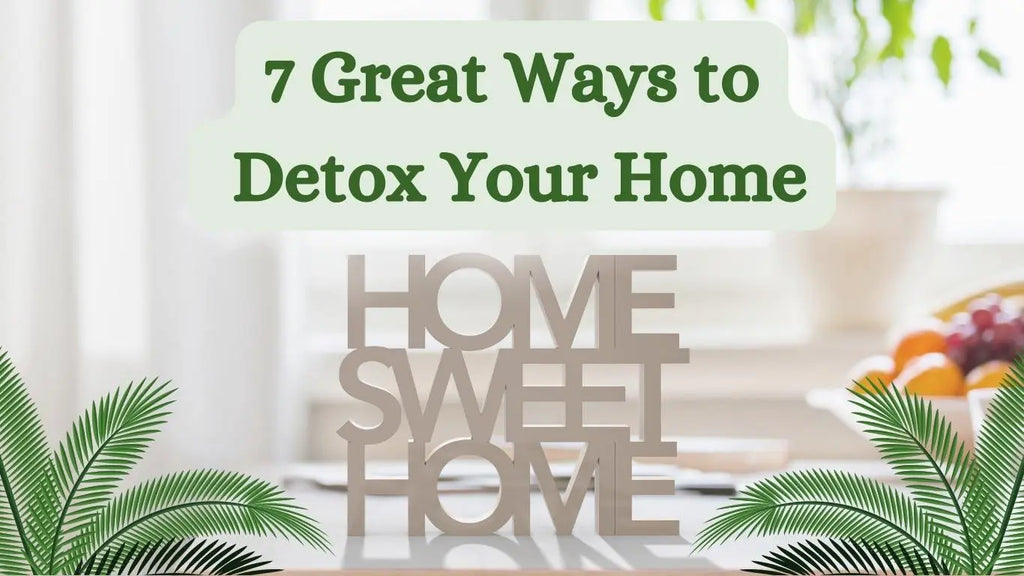7 Great Ways to Detox Your Home

What's in your "home sweet home"? Ever wonder about steps you can take to detox your home, to better support your health and wellness?
(the opinions expressed here are my own!)
It's another new year, and most of us have it on our list of goals to "be healthier" in some way. People often talk about "detoxing" in reference to their bodies and what they eat and/or eliminate. But what about the very environment our bodies are living in most of the time? The air our bodies are breathing in, and the chemicals our bodies are absorbing every day through our skin?
There are a few easy and (mostly) inexpensive ways that we can help reduce our body's toxic chemical load, by making some simple changes to our personal environment: at home. I don't know about you, but when I come home at the end of the day, I want a safe place where I can get some respite from all the chemicals, smog and pollution I was exposed to in the outside world!
The GREAT news is, you can do it! And, some of it on a dime too. 😊
The concept of our home being its own little ecosystem is something that really hit me a few years ago, and is one of the BIG reasons we started our company.
Since "home" is where I live and spend most of my time, I want it be a SAFE space for both me and my loved ones, and my pets.💚
The 2 main goals in a "home detox" are to:
- Eliminate harmful VOCs (Volatile Organic Compounds) from the air we breathe and;
- Eliminate harmful chemicals from the products we use every day on our skin.
Our home's ecosystem feeds into the larger earth's ecosystem as well. From the garbage it produces, to the chemicals it flushes in waste waters down the drain to the fish. 🐟 So I give a lot of thought to what I allow in my home, aka "my personal environment". While I cannot control the quality of the air once I step outside, there's a lot I can do to control the quality of the air I breathe within my own home. I can also control a lot of what my skin absorbs.
1. Change or check your furnace's air filter once a month, religiously.
Let's call this your home's "liver". It's the air filter on your furnace that has the fun job of filtering out all the nasties floating around (and keeping them out of your lungs), so be nice to your home's liver and just do it. I set a monthly reminder in my phone, otherwise I forget!
Ever have that AWFUL experience of waiting too long to change the filter, and that "eww" moment that comes next when you realize that you've just been breathing in THAT black stuff in the past few months? If you're one of those super organized people that this has never happened to, I commend you! (And, I also don't recommend you ever experience this, lol.😂)
While most furnace filters are designed to be changed every 1 to 3 months, some filters are designed to last 3 or 6 months or even more. But it isn't an exact science. You're better to check it more often because if the air is REALLY dirty one week, you'll need to change it much sooner. Especially if you do any renovations, or there is construction in your neighbourhood!
ON A DIME: Consider switching to a washable and reusable furnace filter which will save you money in the long run. Plus, it's the more eco option, by reducing waste from disposable filters.
PS - don't forget to clean your vacuum filter, the same principle applies!
2. Plants. Plants. More plants! 😄
Did you know that plants basically EAT CO2 Carbon Dioxide? When we breathe out, we're basically nourishing our plants! The exciting part is that plants breathe out to feed us OXYGEN in return. (And they filter out all kinds of nasties in the air, too).
Great plants for filtering the air and improving your indoor air quality specifically are: snake plants, English ivy, peace lilies and bamboo palm.
And, ALL plants filter out formaldehyde from the air. Bonus!
The NASA Clean Air Study first published in 1989 on the subject of plants and their effect on indoor air quality is truly fascinating, and worth a read, if you want to geek out. Plants help filter out VOC's (Volatile Organic Compounds) like Benzene, Formaldehyde...and many more chemicals that are pretty darn harmful to human health.
ON A DIME: check Facebook Marketplace often. A lot of times, people are just giving plants away for free, or for just a few dollars. Also check your local hardware store in the off-season, because you'll often find those gorgeous big monster plants on clearance under $20. Lastly, don't forget to ask your friends! Happy plants multiply like rabbits. I'm always giving the plant babies away!

3. Choose CLEAN (non-parraffin) candles
Studies have shown that burning parraffin wax (a petroleum by-product) candles releases carcinogenic toxins like toluene, formaldehyde and benzyne into the air.
Instead, choose candles made from soy wax, beeswax or non-parrafin sources.
ON A DIME: If you're looking for that lovely smell in the house but don't want to drop coin on expensive soy or beeswax candles, try popping a pot of water on the stove (or crockpot) to gently simmer fragrant items like orange peels, cinnamon sticks, star anise, vanilla, apple peels and basically, most fruit peels work well. The combo of rosemary and lemon peels is another nice one!
4. Choose CLEAN and natural home scents (that don't contain undisclosed "fragrance" on the label's ingredients)
Avoid home "fragrance" sprays, plug-ins and anything with the word "fragrance" or "parfum" on the label AND that do not disclose the chemical composition of the fragrance. And when they do, it's worth researching what those chemicals are. Many contain formaldehyde! Yikes. Really need to check ingredients, to know what you'll be breathing in.
Most home fragrance sprays on the market are chock full of chemicals, and VOCs.
ON A DIME: Consider instead a home diffuser with a little blend of a few drops of essential oils mixed with water, or a simmering pot of water and spices on the stove.
5. Choose CLEAN and natural cleaning products - that don't require you to wear rubber gloves.
⚠️Many of the very worst chemicals are found in cleaning products specifically.
So if there is ever a FIRST detox swap to make, consider switching to all natural cleaning products that do not contain harmful chemicals and artificial fragrance.
By the way - If your hands feel like sandpaper after washing dishes, that's a big clue about how your body feels about the ingredients in your dish soap, just sayin'.
Like human sponges, our skin has over 5 MILLION pores. What we put on our skin is then absorbed into our bloodstream. Many dish soaps contain known neurotoxic biocides and endocrine disrupters like Methylisothiazolinone and Phenoxyethanol, copolymers (liquid plastic), SLS (a skin irritant), and "fragrance" (aka - non-disclosed "chemical soup" blend). And, Lauramine Oxide - which is very toxic to aquatic life. So while we are led to think it's safe enough to clean a baby bird, it can actually kill fish and make people very sick!
For a great natural dish soap that is easy on your hands, cuts grease like a champ (without the toxins), and is safe for aquatic life after it goes down the drain, click here.
When it comes to products you're using to clean and spray around the home, think twice about products that require gloves to use. Because:
...unless you're also wearing "lung gloves" or a respirator, you'll be breathing those chemicals right into your bloodstream, and potentially causing damage to your lungs as well.
Luckily, there are so many great natural and chemical-free alternatives out there! 😊
For a 100% non-toxic alternative and natural cleaning spray for all surfaces that WORKS, click here.
6. Be super choosy about the products you put onto your skin every day. 🤔
Read labels. 👀 Research ingredients on the internet. Not all long and complicated names are bad for you, but many are. Education is key!
My personal rule of thumb is to look for products with ingredients that are as close to nature as possible.🌱
And, to avoid any ingredients like "ethoxy-" or "-eth" (ethoxylated), sulfates, talc, "fragrance" or "parfum", parabens, phthalates, mineral oil, aluminum, formaldehyde (listed as "Methanethiol" or "Formic Aldehyde"), BHT ("Butylated Hydroxytoluene"), Triclosan, and coal tar dyes (D&C or FD&C, followed by a chemical colour's name and number).
Because: we don't just absorb what we eat. Think of your skin like another "mouth" into your bloodstream. From lotions and body wash to shampoo, choosing all natural products will allow your body a break from the chemical load. (This is literally, a whole other post!) Check out: "You are What You Absorb: Chemicals to Avoid in Your Products".
7. If you're doing a home renovation project, choose natural materials with low (or no) VOCs, whenever possible.
They DO exist! Many construction materials: from flooring to cupboards to paint, are available in a variety of non-toxic options. A great resource is "Green Building Supply". For example, when we put in a new wood floor in our home, we were able to find a company that made a construction flooring adhesive with little to no VOCs. Most construction materials have a period of "off gassing", where chemicals are slowly leaked into the air you breathe in your home. Off-gassing of VOCs can trigger nasty headaches, and a variety of health issues.
If you're in a new home, or have recently completed a renovation with materials containing VOCs, this may be the time to consider investing in a high-quality indoor air filter and a bunch of plants, to help improve the indoor air quality.
ON A DIME: Many towns and cities have places like "The Restore" ( a division of Habitat for Humanity), where you can find leftover construction materials for a fraction of the cost of new. What I like about this is (besides it keeping things out of landfill!), is that many of these materials have had a chance to off gass whatever VOCs they may contain for a while, which isn't perfect but helps. I am by no means an expert on this topic, but all I can say is that whenever you can, try to select natural materials that don't have a lot of chemicals added.
----------------------------------
I hope you found some things in this article helpful. The road to wellness is a journey built on a collection of single steps, and sure doesn't happen overnight! But ANY healthy step you can take to detox your home, is a step in the right direction. 😊
Cheering you on!
xo
Kirsten


